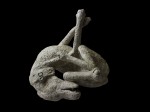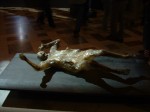 When Vesuvius erupted on August 24th, 79 A.D., a column of ash and pumice rained down on Pompeii, depositing as much as a foot per hour in some parts of the city. Fleeing the shower of stone and ash, many people took shelter in buildings, a deadly choice as it happened, since within six hours from the beginning of the eruption, the weight of accumulated pumice fall caused roofs and walls to collapse. An anomalously high percentage of the remains of people who died in this phase of the eruption — 345 individuals, or 88% of the people killed during the pumice fall deposit phase — were found indoors, killed by the buildings they had taken fled to for protection. Out of the people found outdoors (49 of them, or 12% of the pumice fall victims), most of them were probably killed by debris from collapsing structures. The rest were likely felled by larger stones striking them at ballistic speeds.
When Vesuvius erupted on August 24th, 79 A.D., a column of ash and pumice rained down on Pompeii, depositing as much as a foot per hour in some parts of the city. Fleeing the shower of stone and ash, many people took shelter in buildings, a deadly choice as it happened, since within six hours from the beginning of the eruption, the weight of accumulated pumice fall caused roofs and walls to collapse. An anomalously high percentage of the remains of people who died in this phase of the eruption — 345 individuals, or 88% of the people killed during the pumice fall deposit phase — were found indoors, killed by the buildings they had taken fled to for protection. Out of the people found outdoors (49 of them, or 12% of the pumice fall victims), most of them were probably killed by debris from collapsing structures. The rest were likely felled by larger stones striking them at ballistic speeds.
Most of the remains discovered, 650 people, were found in pyroclastic density currents (PDCs) deposit, 334 (51%) of them outdoors, 316 (49%) indoors. There is no evidence that they were burned to death. They were encased by fine ash and covered by the pyroclastic flow that blanketed the town, sealing in the ash and pumice layer and suffocating the people trapped underneath it to death.
 The ash and pyroclastic layers hardened quickly around the bodies. The soft tissues decomposed over time, leaving only bones in cavities once occupied by whole bodies. More than 1700 years later, excavators of the ancient site noticed that underneath the skeletal remains of a young woman was an imprint of her breasts and body. They didn’t know how to preserve it, however, so the imprint was lost as excavations continued, as were similar such finds.
The ash and pyroclastic layers hardened quickly around the bodies. The soft tissues decomposed over time, leaving only bones in cavities once occupied by whole bodies. More than 1700 years later, excavators of the ancient site noticed that underneath the skeletal remains of a young woman was an imprint of her breasts and body. They didn’t know how to preserve it, however, so the imprint was lost as excavations continued, as were similar such finds.
The breakthrough came on February 5th, 1863, when Giuseppe Fiorelli, Pompeii’s director of works who introduced a revolutionary new scientific rigor to the excavation of the city, was told by a labourers that they had found a cavity with bones at the bottom. Fiorelli told them to stop digging immediately and had plaster poured into that cavity and two others found nearby. They waited two days for the plaster to dry and then chipped away the ash exposing the cast of a person killed during the eruption of Vesuvius almost 1800 years earlier. Facial expressions, clothes, the position of the bodies all were perfectly captured by the plaster casts.
 Plaster had been used once before in 1856 to capture an imprint in the ash, but it was the imprint of a long-gone architectural feature, not of a human being. That was Fiorelli’s brilliant innovation. He remained director of works until 1875. Under his leadership, plaster casts were made of people, animals — most famously the dog on its back with four legs in the air found in the House of Orpheus — furniture, doors, window frames, even the holes in the ground left by roots. The plaster casts of roots allowed archaeologists to identify plants with enough precision to recreate the landscaped pleasure gardens of the wealthy a well as the more practical vegetable gardens that fed the people of Roman-era Pompeii.
Plaster had been used once before in 1856 to capture an imprint in the ash, but it was the imprint of a long-gone architectural feature, not of a human being. That was Fiorelli’s brilliant innovation. He remained director of works until 1875. Under his leadership, plaster casts were made of people, animals — most famously the dog on its back with four legs in the air found in the House of Orpheus — furniture, doors, window frames, even the holes in the ground left by roots. The plaster casts of roots allowed archaeologists to identify plants with enough precision to recreate the landscaped pleasure gardens of the wealthy a well as the more practical vegetable gardens that fed the people of Roman-era Pompeii.
 It was the expressive pathos of the human figures, their final moments frozen in time by the volcano that killed them, that has made a profound impression in all who have seen them since 1863. Luigi Settembrini, professor of Italian literature at the University of Naples, visited the site just a few days after the first castings were made. That night, February 13th, 1863, unable to sleep, he wrote a letter to Fiorelli.
It was the expressive pathos of the human figures, their final moments frozen in time by the volcano that killed them, that has made a profound impression in all who have seen them since 1863. Luigi Settembrini, professor of Italian literature at the University of Naples, visited the site just a few days after the first castings were made. That night, February 13th, 1863, unable to sleep, he wrote a letter to Fiorelli.
It’s impossible to see those three cast figures and not feel moved. […] They’ve been dead for 18 centuries, but they are human creatures seen in their agony. This is not art, not imitation, but their bones, the reliquaries of their flesh and clothes mixed with plaster: it’s the pain of death that reacquired body and shape. […] Up until now there have been discovered temples, houses and other objects to interest the curiosity of cultured people, artists and archaeologists, but now you, oh my Fiorelli, have discovered human pain, and whoever is human feels it.
 The filling of the cavities with plaster has continued ever since. In 1984 they tried a different medium, resin instead of plaster. Inspired by the lost wax method of bronze casting, archaeologists injected wax into the cavity left by the body of a young woman found in the Villa of Lucius Crassius Tertius in Oplontis. Once the wax was hardened, it was coated in plaster. The wax was then melted and the empty plaster cast filled with liquid epoxy resin. The result was a transparent cast through which you could see the Maiden of Oplontis’ bones and her jewelry in situ. Although its transparency and durability are marked advantages, resin casting is complicated, time consuming and expensive. Today Pompeii’s archaeologists are still using plaster. It’s a tricky process. Only a small percentage of the remains found can be cast — there are only around 100 plaster casts (including animals) out more than 1,100 bodies found — due to the condition of the ash shell, and the bones are very brittle. The plaster has to be thick enough to support the bones suspended in it but thin enough to flow freely into nooks and crannies so it can capture all possible detail.
The filling of the cavities with plaster has continued ever since. In 1984 they tried a different medium, resin instead of plaster. Inspired by the lost wax method of bronze casting, archaeologists injected wax into the cavity left by the body of a young woman found in the Villa of Lucius Crassius Tertius in Oplontis. Once the wax was hardened, it was coated in plaster. The wax was then melted and the empty plaster cast filled with liquid epoxy resin. The result was a transparent cast through which you could see the Maiden of Oplontis’ bones and her jewelry in situ. Although its transparency and durability are marked advantages, resin casting is complicated, time consuming and expensive. Today Pompeii’s archaeologists are still using plaster. It’s a tricky process. Only a small percentage of the remains found can be cast — there are only around 100 plaster casts (including animals) out more than 1,100 bodies found — due to the condition of the ash shell, and the bones are very brittle. The plaster has to be thick enough to support the bones suspended in it but thin enough to flow freely into nooks and crannies so it can capture all possible detail.
 Because the casts are human remains, archaeologists have been reluctant to restore them. The very old plaster has begun to degrade, however, exposing the bones inside. Now, as part of the Great Pompeii Project, a program of restoration and stabilization of many endangered areas of the ancient archaeological site, all 86 plaster casts of human remains are being restored. The plaster is being rehydrated where possible and repaired where it has crumbled away. The casts have been X-rayed and laser scanned so archaeologists knew exactly where everything inside was before they began to work on the plaster. With the precise data mapping of the laser scan, restorers have also been able to create precise replicas of the cast with 3D printing. That will be very helpful going forward for traveling exhibitions and the like.
Because the casts are human remains, archaeologists have been reluctant to restore them. The very old plaster has begun to degrade, however, exposing the bones inside. Now, as part of the Great Pompeii Project, a program of restoration and stabilization of many endangered areas of the ancient archaeological site, all 86 plaster casts of human remains are being restored. The plaster is being rehydrated where possible and repaired where it has crumbled away. The casts have been X-rayed and laser scanned so archaeologists knew exactly where everything inside was before they began to work on the plaster. With the precise data mapping of the laser scan, restorers have also been able to create precise replicas of the cast with 3D printing. That will be very helpful going forward for traveling exhibitions and the like.
This video, which I would strongly recommend muting, shows an overview of the restoration, starting with the casts being moved from the areas of the archaeological site where they’ve been on display to the restoration workshop (set up in one of Pompeii’s ancient buildings) of the Special Superintendency for the Archaeological Heritage of Naples and Pompeii. It’s remarkable how much it looks like the wounded being carried on stretchers to a field hospital full of war casualties.
[youtube=https://youtu.be/fnBwgJQzbgQ&w=430]
Twenty of the restored casts will go on display in Pompeii’s amphitheater as part of the Pompeii and Europe exhibition starting May 27th and running through November 2nd. The exhibition will take place concurrently at the Naples National Archaeological Museum.